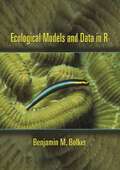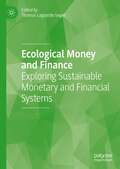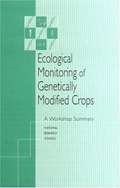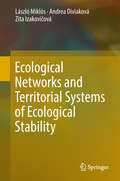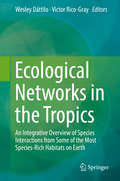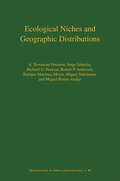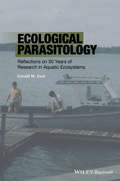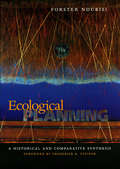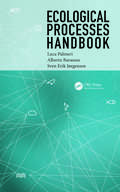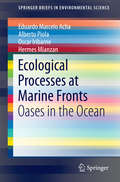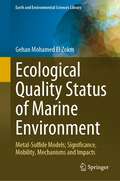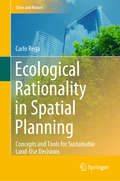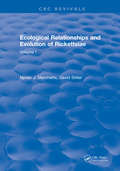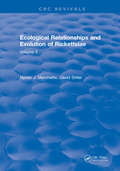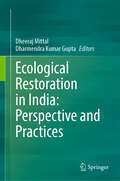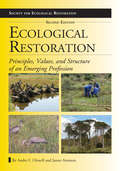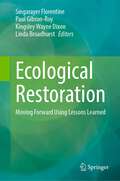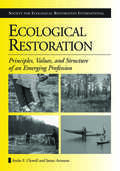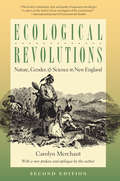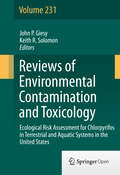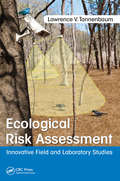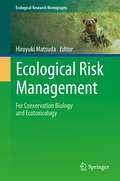- Table View
- List View
Ecological Models and Data in R
by Benjamin M. BolkerEcological Models and Data in R is the first truly practical introduction to modern statistical methods for ecology. In step-by-step detail, the book teaches ecology graduate students and researchers everything they need to know in order to use maximum likelihood, information-theoretic, and Bayesian techniques to analyze their own data using the programming language R. Drawing on extensive experience teaching these techniques to graduate students in ecology, Benjamin Bolker shows how to choose among and construct statistical models for data, estimate their parameters and confidence limits, and interpret the results. The book also covers statistical frameworks, the philosophy of statistical modeling, and critical mathematical functions and probability distributions. It requires no programming background--only basic calculus and statistics. Practical, beginner-friendly introduction to modern statistical techniques for ecology using the programming language R Step-by-step instructions for fitting models to messy, real-world data Balanced view of different statistical approaches Wide coverage of techniques--from simple (distribution fitting) to complex (state-space modeling) Techniques for data manipulation and graphical display Companion Web site with data and R code for all examples
Ecological Money and Finance: Exploring Sustainable Monetary and Financial Systems
by Thomas Lagoarde-SegotThis book provides a detailed overview of ecological money and finance. The functioning and development of the monetary and financial systems are analysed in relation to sustainability constraints to highlight the actions required to meet the 2030 Sustainable Development Agenda. Empirical case studies are utilized to give insight into the failure of the traditional financial system, with ways in which they can be overcome also considered. This book adopts a pluralist perspective to revisit the foundations of financial and monetary economics from a sustainability perspective, and examines the economic and financial instruments that can be used to combat ecological challenges. It will be relevant to students and researchers interested in ecological economics and sustainable finance.
Ecological Monitoring of Genetically Modified Crops: A Workshop Summary
by Robert PoolInformation on Ecological Monitoring of Genetically Modified Crops
Ecological Networks and Territorial Systems of Ecological Stability
by László Miklós Zita Izakovičová Andrea DiviakováThis book provides a wealth of information for all those involved in using ecological networks for biodiversity protection and environmental management, as well as their significance for planning. It describes the concept of ecological networks, and presents methods and real-world examples of the use of a territorial system of ecological stability (TSES) in Slovakia at national, regional and local levels, including the assessment of the significance of biocentres, biocorridors and interactive elements. Using both a functional model for preserving the living conditions of habitats or preventing their collapse, and the connectivity of biotopes in a landscape as an original type of ecological network based on landscape-ecological principles, TSES represents a modern concept of nature and biodiversity protection based on the principles of protection of the conditions and forms of biota.
Ecological Networks in the Tropics: An Integrative Overview of Species Interactions from Some of the Most Species-Rich Habitats on Earth
by Wesley Dáttilo Victor Rico-GrayBased on graph theory studies this book seeks to understand how tropical species interact with each other and how these interactions are affected by perturbations in some of the most species-rich habitats on earth. Due to the great diversity of species and interactions in the tropics, this book addresses a wide range of current and future issues with empirical examples and complete revisions on different types of ecological networks: from mutualisms to antagonisms. The goal of this publication is not to be only for researchers but also for undergraduates in different areas of knowledge, and also to serve as a reference text for graduate-level courses mainly in the life sciences.
Ecological Niches and Geographic Distributions (Monographs in Population Biology #49)
by Robert P. Anderson A. Townsend Peterson Enrique Martínez-Meyer Miguel Nakamura Richard G. Pearson Jorge Soberón Miguel B. AraújoThis book provides a first synthetic view of an emerging area of ecology and biogeography, linking individual- and population-level processes to geographic distributions and biodiversity patterns. Problems in evolutionary ecology, macroecology, and biogeography are illuminated by this integrative view. The book focuses on correlative approaches known as ecological niche modeling, species distribution modeling, or habitat suitability modeling, which use associations between known occurrences of species and environmental variables to identify environmental conditions under which populations can be maintained. The spatial distribution of environments suitable for the species can then be estimated: a potential distribution for the species. This approach has broad applicability to ecology, evolution, biogeography, and conservation biology, as well as to understanding the geographic potential of invasive species and infectious diseases, and the biological implications of climate change. The authors lay out conceptual foundations and general principles for understanding and interpreting species distributions with respect to geography and environment. Focus is on development of niche models. While serving as a guide for students and researchers, the book also provides a theoretical framework to support future progress in the field.
Ecological Parasitology
by Gerald EschProfessor Gerald Esch has already published two books in what is becoming an informal series of essays exploring the way that discoveries about the biology of parasites have influenced ecological and evolutionary theories over a career that has spanned nearly 50 years. This book will be the third set of essays and will focus on key moments of discovery and explore how these achievements were due to collaboration, mentoring, and community building within the field of ecological parasitology. The book will not only describe case studies, pure science and biology but also act as a career guide for early-career ecologists emphasizing the importance of collaboration in the advancement of science.
Ecological Physiology of Daily Torpor and Hibernation (Fascinating Life Sciences)
by Fritz GeiserThis book provides an in-depth overview on the functional ecology of daily torpor and hibernation in endothermic mammals and birds. The reader is well introduced to the physiology and thermal energetics of endothermy and underlying different types of torpor. Furthermore, evolution of endothermy as well as reproduction and survival strategies of heterothermic animals in a changing environment are discussed.Endothermic mammals and birds can use internal heat production fueled by ingested food to maintain a high body temperature. As food in the wild is not always available, many birds and mammals periodically abandon energetically costly homeothermic thermoregulation and enter an energy-conserving state of torpor, which is the topic of this book. Daily torpor and hibernation (multiday torpor) in these heterothermic endotherms are the most effective means for energy conservation available to endotherms and are characterized by pronounced temporal and controlled reductions in body temperature, energy expenditure, water loss, and other physiological functions. Hibernators express multiday torpor predominately throughout winter, which substantially enhances winter survival. In contrast, daily heterotherms use daily torpor lasting for several hours usually during the rest phase, some throughout the year. Although torpor is still widely considered to be a specific adaptation of a few cold-climate species, it is used by many animals from all climate zones, including the tropics, and is highly diverse with about 25-50% of all mammals, but fewer birds, estimated to use it. While energy conservation during adverse conditions is an important function of torpor, it is also employed to permit or facilitate energy-demanding processes such as reproduction and growth, especially when food supply is limited. Even migrating birds enter torpor to conserve energy for the next stage of migration, whereas bats may use it to deal with heat. Even though many heterothermic species will be challenged by anthropogenic influences such as habitat destruction, introduced species, novel pathogens and specifically global warming, not all are likely to be affected in the same way. In fact it appears that opportunistic heterotherms because of their highly flexible energy requirements, ability to limit foraging and reduce the risk of predation, and often pronounced longevity, may be better equipped to deal with anthropogenic challenges than homeotherms. In contrast strongly seasonal hibernators, especially those restricted to mountain tops, and those that have to deal with new diseases that are difficult to combat at low body temperatures, are likely to be adversely affected. This book addresses researchers and advanced students in Zoology, Ecology and Veterinary Sciences.
Ecological Planning: A Historical and Comparative Synthesis (Center Books on Contemporary Landscape Design)
by Forster NdubisiChosen by Choice Magazine as an Outstanding Academic Title for 2003Ecological planning is the process of understanding, evaluating, and providing options for the use of landscape to ensure a better fit with human habitation. In this ambitious analysis, Forster Ndubisi provides a succinct historical and comparative account of the various approaches to this process. He then reveals how each of these approaches offers different and uniquely useful perspectives for understanding the dialogue between human and environmental processes. Ndubisi begins by examining the philosophies behind and major contributors to ecological thinking during the past 150 years, as well as the paradigm shift in planning that occurred in recent decades as a result of a growing global ecological awareness. He then turns to landscape suitability analysis and discusses alternative approaches to ecological planning, such as applied human ecology, applied landscape ecology, and others. Finally, he offers a comparative synthesis of the approaches in order to reveal the theoretical and methodological assumptions inherent when planners choose one approach over the other. Ndubisi concludes that no one approach can by itself adequately address the whole spectrum of ecological planning issues. For this reason he offers guidance as to when it may be appropriate for landscape architects and planners to emphasize one approach rather than another.
Ecological Processes Handbook (Applied Ecology and Environmental Management)
by Sven Erik Jorgensen Luca Palmeri Alberto BarausseEcology is cross-disciplinary field involving many different aspects of science. Written with this in mind, this book introduces ecological processes, ranging from physical processes, to chemical processes and biological processes. It contains all the necessary information on an ecological process: a clear, detailed but not too lengthy definition,
Ecological Processes at Marine Fronts
by Eduardo Marcelo Acha Alberto Piola Oscar Iribarne Hermes MianzanThis book reviews and summarizes the results and hypotheses raised by studies directly or indirectly dealing with the ecology of fronts and aims to identify the themes that connect them to produce a synthesis of this knowledge. Though not immediately perceived the ocean is highly structured and fronts are one of the most important components of its structural complexity. Marine fronts have been known since the early 20th Century, however, the more recent availability of high resolution satellite imagery, field measurements and numerical simulations have greatly advanced our understanding of their ecological impact. This work touches on topics such as front types, its biology and its comparisons with other bounderies at sea, as well as comparisons of fronts with terrestrial boundaries and the 'ecotone' concept. Furthermore, it also looks at the management and conservation of marine life.
Ecological Quality Status of Marine Environment: Metal- Sulfide Models; Significance, Mobility, Mechanisms and Impacts (Earth and Environmental Sciences Library)
by Gehan Mohamed El ZokmThe goal of this one-of-a-kind book was to provide a critical and in-depth understanding of various AVS-SEM models as predictors for assessing the ecological impact of heavy metals (particularly dibasic cations; Zn, Cd, Ni, Cu, and Pb) on aquatic environments, including the theories underlying these models, descriptive equations, modes of action, methodology, efficiency, applicability, and statistical approaches, as well as comparison with other pollution assessment techniques in the aquatic environments. Metals in interstitial water can be reduced in sediments that co-precipitate with iron (Fe) and manganese (Mn) in FeS or MnS minerals, as well as replace them. This book outlines a system that can be used to track heavy metal contamination in countries with coastal regions that extend over water bodies that are subjected to pollution sources, such as the Mediterranean Basin countries. Moreover, this book will be of great interest to academics, professionals, practitioners, post-graduate students (M.Sc. and Ph.D.), and undergraduates because it gives a clear overview of heavy metal assessment for people interested in environmental studies focusing on the marine environment. It also provides decision-makers with a realistic perspective of the environmental file, allowing them to address environmental issues and directing stockholders to safer locations for environmental activity. From a future perspective, management is advised to overcome the difficulties within that technique, such as accurate handling procedures and different approaches to sampling onshore and offshore. Sequential leaching strategies, especially geochemical fractionation analysis, and knowledge of the interactions and significance of AVS in the marine sector, especially toxicity tests (bioassay) are recommended.
Ecological Rationality in Spatial Planning: Concepts and Tools for Sustainable Land-Use Decisions (Cities and Nature)
by Carlo RegaSpatial planning defines how men use one of the most important and scarce resources on Earth: land. Planners therefore play a key role in countering or deepening the current ecological crisis. To foster ecological transitions, planning scholars and practitioners need to be equipped with sound theories and practical tools. To this end, this book advocates a re-foundation of spatial planning under the paradigm of “ecological rationality”, based on the revaluation of early pioneers of ecological planning and mutual fertilization with different disciplines, including decision-making science, ecology, (eco)system theory, land use science and political ecology.The key principles of ecological rationality and its application to spatial planning are discussed and this conceptual framework is used to explain the main underlying drivers of ecological degradation and their spatial manifestations at the local level. Current policy instruments in the European context, which can be used to underpin ecological planning, such as Green Infrastructure and the Mapping and Assessment of Ecosystem Service (MAES) initiative, are also examined.
Ecological Relationships and Evolution of Rickettsiae: Volume I
by Nyven J. MarchetteFirst Published in 2018. Routledge is an imprint of Taylor & Francis, an Informa company.
Ecological Relationships and Evolution of Rickettsiae: Volume II
by Nyven J. MarchetteFirst Published in 2018. Routledge is an imprint of Taylor & Francis, an Informa company.
Ecological Restoration in India: Perspective and Practices
by Dharmendra Kumar Gupta Dheeraj MittalThis edited book provides a comprehensive exploration of ecological restoration in India, offering insights into the latest perspectives and practices. Through this book, readers will learn about the policy frameworks, best practices, and case studies that are shaping the future of ecological restoration in India. The chapters cover topics such as grassland restoration, habitat restoration for wildlife, and the rehabilitation of mined-out and fire-affected areas. Contributions from renowned experts delve into critical issues like legislative mandates, international commitments, and socio-economic impacts. This collection invites readers to think through questions such as how to achieve land degradation neutrality and the role of ecological restoration in sustainable development. Ideal for government officers, policy makers, foresters, ecologists, and academicians, this book is a valuable resource for anyone involved in environmental science, biodiversity conservation, and climate change. It offers both Indian and international perspectives, making it a must-read for those interested in the global discourse on ecological restoration.
Ecological Restoration, Second Edition: Principles, Values, and Structure of an Emerging Profession (Science Practice Ecological Restoration)
by James Aronson Andre F. ClewellEcological restoration is a rapidly growing discipline that encompasses a wide range of activities and brings together practitioners and theoreticians from a variety of backgrounds and perspectives, ranging from volunteer backyard restorationists to highly trained academic scientists and professional consultants. This book offers a comprehensive and coherent account of the field for everyone who initiates, finances, designs, administers, issues government permits for, manages, and implements ecological restoration projects, and all those who serve in supportive roles. Originally published in 2007, this revised and reorganized edition brings the book up to date with new developments and current trends in the field. In a lively, personal fashion, the authors discuss scientific and practical aspects of the field as well as the human needs and values that motivate practitioners. The book *identifies fundamental concepts upon which restoration is based *considers the principles of restoration practice *explores the diverse values that are fulfilled with the restoration of ecosystems *reviews the structure of restoration practice, including the various contexts for restoration work, the professional development of its practitioners, and the relationships of restoration with allied fields and activities The book also includes case studies and Virtual Field Trips around the world that illustrate points made in the book with on-the-ground information from those who were intimately involved with the projects described. Throughout, ecological restoration is conceived as a holistic endeavor, one that addresses issues of ecological degradation, biodiversity loss, personal engagement, and sustainability science simultaneously, and draws upon cultural resources and local skills and knowledge in restoration work.
Ecological Restoration: Moving Forward Using Lessons Learned
by Singarayer Florentine Paul Gibson-Roy Kingsley Wayne Dixon Linda BroadhurstEcological restoration, although a relatively new endeavour compared to other disciplines, has gained significant momentum during the last decade as accelerating global change becomes more apparent. It is now widely accepted by the scientific community that to avoid further devastating effects of climate change and biodiversity loss, humanity must determinedly move more to protect and restore natural ecosystems. Many restoration efforts of the past have been ad hoc, site and situation-specific and have often failed to achieve desired outcomes, but over the last decade, many countries are allocating increasingly significant amounts of financial investment towards restoration with the goal of achieving more systematic and predictable outcomes. Today, activities related to restoring ecosystems, natural assets and biodiversity are a global focus. This book covers a wide range of topics related to ecological restoration including for grasslands, wetlands, temperate and tropical forests and arid zones. Importantly, it also focuses on ecological restoration in human-disturbed landscapes such as for urban areas, farmlands, mine sites and transport corridors. It highlights the necessity for evidence-based approaches that are both nuanced and complementary with prescriptions for people-based restoration, that is socially inclusive and cognisant of historic and current community sentiment. Ambitious landscape and continental scale targets for ecological restoration have been set across the globe. However, without practical guidelines developed from restoration evaluations from the recent past to follow, future efforts are unlikely to be successful, nor -expected targets met. To that end, this book reviews and highlights a large number and variety of restoration stories from around the world. Most are presented as reader-friendly case studies, that feature innovative and systematic techniques for undertaking species-rich ecological restoration. Together they provide inspiration for current and future professionals and offer unique glimpses into state-of-the-art practice for this critically important discipline
Ecological Restoration: Principles, Values, and Structure of an Emerging Profession (Science Practice Ecological Restoration)
by James Aronson Andre F. ClewellThe field of ecological restoration is a rapidly growing discipline that encompasses a wide range of activities and brings together practitioners and theoreticians from a variety of backgrounds and perspectives, ranging from volunteer backyard restorationists to highly trained academic scientists and professional consultants. Ecological Restoration offers for the first time a unified vision of ecological restoration as a field of study, one that clearly states the discipline's precepts and emphasizes issues of importance to those involved at all levels. In a lively, personal fashion, the authors discuss scientific and practical aspects of the field as well as the human needs and values that motivate practitioners. The book: -identifies fundamental concepts upon which restoration is based -considers the principles of restoration practice -explores the diverse values that are fulfilled with the restoration of ecosystems -reviews the structure of restoration practice, including the various contexts for restoration work, the professional development of its practitioners, and the relationships of restoration with allied fields and activities A unique feature of the book is the inclusion of eight "virtual field trips," short photo essays of project sites around the world that illustrate various points made in the book and are "led" by those who were intimately involved with the project described. Throughout, ecological restoration is conceived as a holistic endeavor, one that addresses issues of ecological degradation, biodiversity loss, and sustainability science simultaneously, and draws upon cultural resources and local skills and knowledge in restoration work.
Ecological Reviews: Peatland Restoration and Ecosystem Services
by Martin Evans Hans Joosten Bonn, Aletta and Allott, Tim and Evans, Martin and Joosten, Hans and Stoneman, Rob Aletta Bonn Tim Allott Rob StonemanPeatlands provide globally important ecosystem services through climate and water regulation or biodiversity conservation. While covering only 3% of the earth's surface, degrading peatlands are responsible for nearly a quarter of carbon emissions from the land use sector. Bringing together world-class experts from science, policy and practice to highlight and debate the importance of peatlands from an ecological, social and economic perspective, this book focuses on how peatland restoration can foster climate change mitigation. Featuring a range of global case studies, opportunities for reclamation and sustainable management are illustrated throughout against the challenges faced by conservation biologists. Written for a global audience of environmental scientists, practitioners and policy makers, as well as graduate students from natural and social sciences, this interdisciplinary book provides vital pointers towards managing peatland conservation in a changing environment.
Ecological Reviews: Trophic Ecology
by Hanley, Torrance C. and La Pierre, Kimberly J. Torrance C. Hanley La Pierre, Kimberly J.As researchers try to predict the effects of human modification at all trophic levels and mediate the impact of rapid environmental change, it has become clear it is no longer a matter of agreeing that both bottom-up and top-down forces play important roles in diverse ecosystems. Rather, the question is: how do these forces interact across aquatic and terrestrial systems? Written by leading experts in the field, this book presents a unique synthesis of trophic relationships within and across ecosystems that is a valuable foundation for the development of cross-system, multidisciplinary research. It also provides new insights into population biology and community ecology and examines the interactive effects of bottom-up and top-down forces on biodiversity at each trophic level. A one-stop resource for learning about bottom-up and top-down interactions, this book encourages discussion and collaboration among researchers to identify similarities and differences in trophic interactions across aquatic and terrestrial systems.
Ecological Revolutions Nature, Gender, and Science in New England
by Carolyn MerchantWith the arrival of European explorers and settlers during the seventeenth century, Native American ways of life and the environment itself underwent radical alterations as human relationships to the land and ways of thinking about nature all changed. This colonial ecological revolution held sway until the nineteenth century, when New England's industrial production brought on a capitalist revolution that again remade the ecology, economy, and conceptions of nature in the region. InEcological Revolutions, Carolyn Merchant analyzes these two major transformations in the New England environment between 1600 and 1860. In a preface to the second edition, Merchant introduces new ideas about narrating environmental change based on gender and the dialectics of transformation, while the revised epilogue situates New England in the context of twenty-first-century globalization and climate change. Merchant argues that past ways of relating to the land could become an inspiration for renewing resources and achieving sustainability in the future.
Ecological Risk Assessment for Chlorpyrifos in Terrestrial and Aquatic Systems in the United States
by John P. Giesy Keith R. SolomonReviews of Environmental Contamination and Toxicology attempts to provide concise, critical reviews of timely advances, philosophy and significant areas of accomplished or needed endeavor in the total field of xenobiotics, in any segment of the environment, as well as toxicological implications.
Ecological Risk Assessment: Innovative Field and Laboratory Studies
by Lawrence TannenbaumThis book is a compendium of highly purposeful studies all waiting to be conducted. It explains how avoiding common study design flaws, opportunities are created to observe that true risk assessment questions may not exist, that chemically exposed receptors are probably unharmed, and that ecological risk assessment might not be needed at all.
Ecological Risk Management: For Conservation Biology and Ecotoxicology (Ecological Research Monographs)
by Hiroyuki MatsudaThis book introduces the theory and practice of ecological risk management. Using recent and live case studies in Japan, the book explains the use of basic mathematical techniques in extinction risk, adaptive population management, avian collision risk in wind farms, potential biological removal for marine mammals, and ecological risk assessment of heavy metals. The focus of this book is on case studies of nature conservation in Japan, including internationally renowned topics of Japanese fisheries, Shiretoko World Heritage, Fukushima Daiichi Nuclear Power Plant accident. It also covers the adaptive risk management of the new coronavirus disease.The book comprises four parts covering ecotoxicology, fisheries, wildlife management and conservation, and ecosystem-based management. It differs from other books in having its primary interest in human impacts on animals, plant, and ecosystems, while existing works in this area concentrate on the fate of toxic substances in the environments and their effects on humans. This book is unique in that it indicates various environmental issues that the theoretical ecology is potentially applicable without concentrating into any particular subject such as ecotoxicology or conservation biology. Primary readers are undergraduate/graduate students, staffs of environmental consultant companies and environmental NPOs, and journalists. Readers will find this book useful for its abundant information on case studies of ecological risk management and consensus building in Japan.
